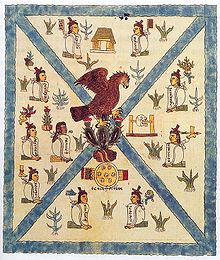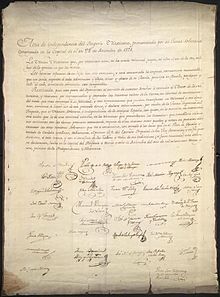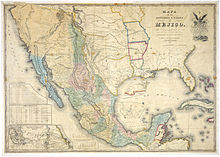- Name of Mexico
-
The name of Mexico entails the origin, history, and use of the name Mexico, which dates back to 14th century Mesoamerica. Mexico was named after its capital, Mexico City, whose original name was Mexico-Tenochtitlan, in reference to the name of the Nahua Aztec tribe, the Mexica. The Nahuatl word Mēxihco is composed of the root Mexi and a suffix -co that means "place" or "city." The full name of the city, Mexico-Tenochtitlan, means "the place of the Mexica among the stone-cactuses," in reference to the image of the eagle perched on a cactus that grew from a stone, in the middle of Lake Texcoco. This image is represented in Mexico's coat of arms and flag.
The official name of the country is the "United Mexican States" (Spanish: Estados Unidos Mexicanos), since it is a federation of thirty-one states. The official name was first used in the Constitution of 1824 , and was retained in the constitutions of 1857 and 1917. Informally, "Mexico" is used along with "Mexican Republic" (República Mexicana).
Contents
The names of the country
When the Spanish conquistadors besieged México-Tenochtitlan in 1521, it was almost completely destroyed. It was rebuilt during the following three years, after which it was designated as a municipality and capital of the vice-royalty of New Spain. In 1524 the municipality of Mexico City was established, known as México Tenustitlan, and as of 1585 became officially known simply Ciudad de México.[1] The name Mexico was used only to refer to the city, and later to a province within New Spain. It was not until the independence of the vice-royalty of New Spain that "Mexico" became the traditional and conventional short-form name of the country.
During the 1810s, different insurgent groups advocated and fought for the independence of the vice-royalty of New Spain. This vast territory was composed of different intendencias and provinces, successors of the kingdoms and captaincies general administered by the vice-regal capital of Mexico City. In 1813, the deputies of the Congress of Anahuac (Congress of Chilpancingo) signed the document Acta Solemne de la Declaración de Independencia de la América Septentrional, ("Solemn Act of the Declaration of Independence of Northern America"). In 1814 the Supreme Congress of the revolutionary forces that met at Apatzingán (in today's state of Michoacán) drafted the first constitution,[2] in 1814 whereby the name América Mexicana ("Mexican America") was chosen for the country. The head of the insurgent forces, however, was defeated by the royalist forces, and the constitution was never enacted.
Servando Teresa de Mier, in a treatise written in 1820 in which he discussed the reasons why New Spain was the only overseas territory of Spain that had not yet secured its independence, chose the term Anáhuac to refer to the country.[3] This term, in Nahuatl, was used by the Mexica to refer to the territory they dominated. According to some linguists, it means "near or surrounded by waters", probably in reference to Lake Texcoco,[4] even though it was also the word used to refer to the world or the terrestrial universe (as when used in the phrase Cem Anáhuac, "the entire earth") and in which their capital, Mexico-Tenochtitlan, was at the centre and at the same time at the centre of the waters, being built on an island in a lake.[5]
In September 1821, the independence of Mexico was finally recognized by Spain, achieved through an alliance of royalist and revolutionary forces. The former tried to preserve the status quo of the vice-royalty, menaced by the liberal reforms taking place in Spain, through the establishment of an autonomous constitutional monarchy under an independence hero. Agustín was crowned and given the titles of: Agustin de Yturbide por la divina providencia y por el Congreso de la Nación, primer Emperador Constitucional de Mexico (Agustín de Yturbide First Constitutional Emperor of Mexico by Divine Providence and by the Congress of the Nation). The name chosen for the country was Imperio Mexicano, "Mexican Empire". The empire collapsed in 1823, and the republican forces drafted a constitution the following year whereby a federal form of government was instituted. In the 1824 constitution, which gave rise to the Mexican federation, Estados Unidos Mexicanos (also Estados-unidos mexicanos) – Mexican United States or Mexican United-States (official English translation: United Mexican States) – was adopted as the country's official name.[6][7] The constitution of 1857 used the term República Mexicana (Mexican Republic) interchangeably with Estados Unidos Mexicanos;[8] the current constitution, promulgated in 1917, only uses the latter[9] and United Mexican States is the normative English translation.[10] The name "Mexican Empire" was briefly revived from 1863 to 1867 by the conservative government that instituted a constitutional monarchy for a second time under Maximilian of Habsburg.
Etymology
The suffix -co is almost certainly the Nahuatl locative, turning the word into a place name. Beyond that, the etymology is uncertain.
According to one legend,[11] the war deity and patron of the Mexica Huitzilopochtli possessed Mexitl or Mexi as a secret name. Mexico would then mean "Place of Mexi" or "Land of the War God."
Another hypothesis[12] suggests that Mēxihco derives from a portmanteau of the Nahuatl words for "moon" (mētztli) and navel (xīctli). This meaning ("Place at the Center of the Moon") might then refer to Tenochtitlan's position in the middle of Lake Texcoco. The system of interconnected lakes, of which Texcoco formed the center, had the form of a rabbit, which the Mesoamericans pareidolically associated with the moon.
Still another hypothesis[12] offers that it is derived from Mectli, the goddess of maguey.
These last two suggestions are depreciated by linguist Frances Karttunen,[13] since the final form "Mēxihco" differs in vowel length from both proposed elements. Nahua toponymy is full of mysticism, however, as it was pointed out by the Spanish missionary Bernardino de Sahagún. In his mystic interpretation, Mexico could mean "Center of the World," and, in fact, it was represented as such in various codices, as a place where all water currents that cross the Anahuac ("world" or "land surrounded by seas") converge (see image on the Mendoza codex). It is thus possible that the other meanings (or even the "secret name" Mexi) were then popular pseudoetymologies.
Phonetic evolution
The Nahuatl word Mēxihco, pronounced [meːˈʃiʔko], was transliterated as "Mexico" using Medieval Spanish orthography, in which the x represented the voiceless postalveolar fricative ([ʃ], the equivalent of English sh in "shop"). At the time, Spanish j represented the voiced postalveolar fricative ([ʒ], like the English s in "vision", or French j today). However, by the end of the fifteenth century j had evolved into a voiceless palato-alveolar sibilant as well, and thus both x and j represented the same sound ([ʃ]). During the sixteenth century this sound evolved into a voiceless velar fricative ([x], like the ch in Scottish "loch"), and México began to be pronounced [ˈmexiko].[14]
Given that both x and j represented the same new sound (/x/), and in lack of a spelling convention, many words that originally had the /ʃ/ sound, began to be written with j (e.g. it wasn't uncommon to find both exército and ejército used during the same time period, even though that due to historicity, the correct spelling would have been exército). The Real Academia Española, the institution in charge of regulating the Spanish language, was established in 1713, and its members agreed to simplify spelling, and set j to represent /x/ regardless of the original spelling of the word, and x to represent /ks/. (The ph spelling underwent a similar removal, in that it was simplified as f in all words, e.g. philosophía became filosofía.)
Nevertheless, there was ambivalence in the application of this rule in Mexican toponyms: México was used alongside Méjico, Texas and Tejas, Oaxaca and Oajaca, Xalixco and Jalisco, etc., as well as in proper and last names: Xavier and Javier, Ximénez and Jiménez are spelling variants still used today. In any case, the spelling Méjico for the name of the country is little used in Mexico or the rest of the Spanish-speaking world today. The Real Academia Española itself recommends the spelling "México".
In present-day Spanish, México is pronounced [ˈmexiko] or [ˈmehiko], the latter pronunciation used mostly in dialects of the Caribbean and some places in South America where [x] has become a voiceless glottal fricative ([h]). In English, however, the x does not represent either the original sound [ʃ] or the modern sound [x], but the spelling pronunciation [z] at the beginnings of words and [ks], [ɡz], or [kʃ] in other positions; thus Mexico is pronounced /ˈmɛksɨkoʊ/ in English.
Normative spelling in Spanish
México is the predominant Spanish spelling variant used throughout Latin America, and universally used in Mexican Spanish, whereas Méjico is used infrequently in Spain and Argentina. During the 1990s, the Real Academia Española recommended that México be the normative spelling of the word and all its derivatives, even though this spelling does not match the pronunciation of the word.[15] Since then, the majority of publications adhere to the new normative in all Spanish-speaking countries even though the disused variant can still be found.[16] The same rule applies to all Spanish toponyms in America, and on some occasions in the Iberian Peninsula, even though in most co-official or regional languages of Spain (Asturian, Leonese and Catalan), the x is still pronounced [ʃ].
References
- ^ Historia de la Ciudad de México Gobierno del Distrito Federal
- ^ Decreto Constitucional para la Libertad de la América Mexicana
- ^ ¿Puede ser libre la Nueva España?
- ^ Universidad Anáhuac
- ^ A Nahuatl Interpretation of the Conquest
- ^ Constitución federal de los Estados Unidos mexicanos (1824)
- ^ Federal Constitution of the United Mexican States (1824) (original scans with English text): The Texas Constitutions Digitization Project, University of Texas at Austin; also see project bibliography
- ^ Constitución Federal de los Estados Unidos Mexicanos (1857)
- ^ Constitución Política de los Estados Unidos Mexicanos (1917)
- ^ 1917 Constitution of Mexico, Official Site of the Mexican Government (English)
- ^ Aguilar-Moreno, M. Handbook to Life in the Aztec World, p. 19. Facts of Life, Inc. (New York), 2006.
- ^ a b Gobierno del Estado de México. Nombre del Estado de México. (Spanish)
- ^ Karttunen, Frances. An Analytical Dictionary of Nahuatl, p. 145. University of Oklahoma Press (Norman), 1992.
- ^ Evolution of the pronunciation of x Real Academia Española
- ^ Real Academia Española Diccionario Panhispánico de Dudas
- ^ "Mexico" Merriam-Webster's Online Dictionary
See also
Name of North America Sovereign states - Antigua and Barbuda
- Bahamas
- Barbados
- Belize
- Canada
- Costa Rica
- Cuba
- Dominica
- Dominican Republic
- El Salvador
- Grenada
- Guatemala
- Haiti
- Honduras
- Jamaica
- Mexico
- Nicaragua
- Panama
- Saint Kitts and Nevis
- Saint Lucia
- Saint Vincent and the Grenadines
- Trinidad and Tobago
- United States
Dependencies and
other territories- Anguilla
- Aruba
- Bermuda
- Bonaire
- British Virgin Islands
- Cayman Islands
- Curaçao
- Greenland
- Guadeloupe
- Martinique
- Montserrat
- Puerto Rico
- Saint Barthélemy
- Saint Martin
- Saint Pierre and Miquelon
- Saba
- Sint Eustatius
- Sint Maarten
- Turks and Caicos Islands
- United States Virgin Islands
Categories:- Country name etymology
- History of Mexico
Wikimedia Foundation. 2010.



